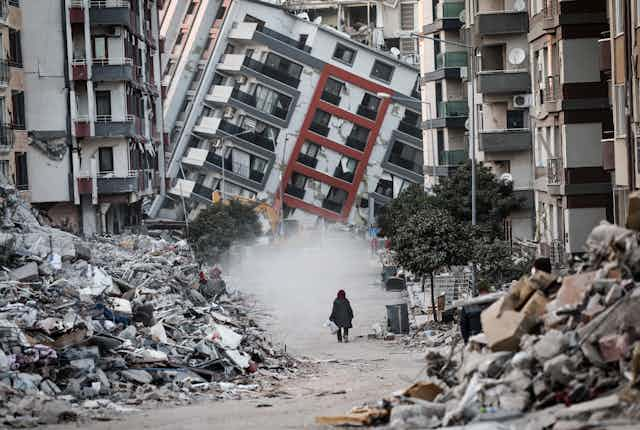In the early hours of February 6 2023, the south-eastern region of Turkey was rocked by a series of powerful earthquakes. One year on, large parts of Hatay, the worst-affected province, remain in ruins. In a vlog from Hatay on January 24, journalist Cüneyt Özdemir remarked: “The city is like a construction site mostly under rubble.”
The first earthquake, measuring 7.8 on the Richter scale, struck near the border with Syria, killing at least 1,500 people as they slept. This was followed by a 7.5-magnitude quake nine hours later, located around 59 miles (95km) to the south-west. Hatay, already in ruins, was shaken again by a 6.4-magnitude tremor two weeks later.
The disaster resulted in the deaths of more than 50,000 people while injuring a further 107,000. A total of 9 million people have been affected, including 1.7 million refugees who had fled the civil war in Syria.
One year on, the region’s economy and society remain shaken. The devastation has exposed deep societal scars, and the task of rebuilding is still immense.
Economic ramifications
The affected areas represented 13.3% of Turkey’s total employment before the earthquakes. The quakes rendered around 220,000 workplaces unusable, leading to a 16% reduction in working hours. Particularly hard-hit provinces such as Hatay, Kahramanmaraş and Malatya lost more than 10% of their combined industrial capacity.
A year on, unemployment remains a dire problem in these areas. Over 230,000 people in the region applied for unemployment benefits throughout 2023, but less than 40% of these applications met the necessary criteria.
The Turkish government has recently launched a programme to help people return to employment in the region. But labour unions view this as a way of providing cheap labour to employers, and have asked the government to focus more on satisfying the urgent needs of workers, such as housing.

Fractured society
The earthquakes shattered not only the region’s economy but the very fabric of society. More than 850,000 buildings collapsed in the initial quakes and the thousands of aftershocks that followed. This exposed inadequacies in construction practices and a widespread lack of compliance with building regulations.
The government pledged to rebuild 650,000 homes within a year – but progress has been slow. A mere 15% of these new homes have been built, and hundreds of thousands of people remain displaced. Today, more than 670,000 people are still living in small, temporary, metal container homes.
The earthquakes also had a profound impact on education in the region. Damage to schools and other educational facilities disrupted the in-class teaching of around 7 million students.
On January 2 2024, Turkey’s minister of education, Yusuf Tekin, admitted that only a quarter of the educational facilities that were destroyed by the quakes have been rebuilt. During the most recent school term (mid-September to mid-January), students were taught mostly in sites under construction.

Roadmap for recovery
Turkey’s government claims to be focusing on “building back better”. Its stated aim is to construct cities and communities that are more resilient to any such shocks in the future. This is commendable (provided it does in fact happen), but it’s crucial that efforts to recover go beyond mere reconstruction.
The government’s response to the disaster has, for example, largely failed women and girls. Following the quakes, women and girls have faced heightened care and domestic work responsibilities, health challenges (particularly related to pregnancy), and an increased susceptibility to violence.
On top of this, they grapple with enduring poverty. A recent report which surveyed 60 women in the affected region revealed that most are earning what is called a “women’s daily wage”. This wage has emerged in the region in the aftermath of the quakes and falls below the national minimum wage, further worsening existing gender inequality in the country.
According to the same report, wages below the minimum wage have become the norm for women in the region – including those women in white-collar jobs.
While the Turkish government’s response to last February’s earthquakes has been widely criticised, it still enjoyed strong support in the national election in the summer of 2023. Turkey’s current government, led by President Recep Tayyip Erdoğan, and its alliance came out on top in ten of the 11 earthquake-affected provinces.
Turkey is now gearing up for local elections this spring. The current political rhetoric is dominated by a focus on replacing old buildings not resistant to major disasters with new ones. But it is clear the affected regions need solutions that include all members of society – which will only be possible with the help of the national government.
Yet, in a speech on February 3 2024, Erdoğan hinted there would be a sustained absence of assistance in the disaster-stricken areas if central government and local administration “do not join hands and are not in solidarity”. However, the nature of this alignment – whether the president meant cooperation or political ideology – remains unclear.


